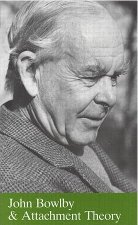 波尔比(1907—1990),
波尔比(1907—1990),
英国心理学家,杰出的儿童精神病学家。他将心理分析、认知心理学和进化生物学等学科统合在一起,纠正了弗洛伊德精神分析理论对童年经历的过分强调和对真正创伤的忽视。1989年获美国心理学会颁发的杰出科学贡献奖。
Born in England
Physician and Psychoanalyst at the University of Cambridge
Developed attachment theory
Classic works: The Nature of the Child’s Tie to His Mother (1958),
Separation Anxiety (1960), Grief and Mourning in Infancy and Early
Childlhood (1960)
THE ORIGINS OF ATTACHMENT THEORY:JOHN BOWLBY AND MARY AINSWORTH
www.geocities.com/Athens/Acropolis/3041/bio.html
John Bowlby’s background
John Bowlby was born in 1907 in London to an upper-middle-class family. He was the fourth of six children and he was raised by a nanny in a traditional English fashion. His father, Sir Anthony Bowlby, second Baronet Bowlby, was a surgeon who had a traumatic history. When Sir Anthony was just five years old, his father, who had been serving as a war correspondent in the Anglo-Chinese Opium War, was brutally killed. Normally, Bowlby saw his mother only one hour a day after teatime. During the summer she was more available. She thought that spoiling her children was dangerous, so that attention and affection was the opposite of what was required. When Bowlby was almost four years old, his beloved nanny, who was his primary caretaker, left the family. Later, he was to describe this as tragic as the loss of a mother.
At the age of seven Bowlby was sent off to boarding school, because his father had to work as surgeon in a war. His ater work, for example Separation, Anxiety and Anger shows that this was a terrible time for him. Because of his experiences as a child he had an unusual sensitivity to children’s suffering during his entire life.
His intellectual career started at the University of Cambridge, were he studied psychology and pre-clinical sciences. He won prizes for outstanding intellectual performance. After Cambridge he took some time to work with maladjusted and delinquent children. At the age of twenty-two, he enrolled at University College Hospital in London, at the age of twenty-six he qualified in medicine. While still in medical school he also found time to enroll himself in the Institute for Psychoanalysis. After graduation of medical school he went off to train in adult psychiatry at the Maudsley Hospital. In 1937, he qualified as an analyst. Because of his former work with maladapted and delinquent children, he became interested in the development of children and started working at the Child Guidance Clinic in London.
Bowlby was interested in finding out the actual patterns of family interaction involved in both healthy and pathological development. He focused on how attachment difficulties were transmitted from one generation to the next. The three most important experiences for Bowlby’s future work and the development of attachment theory were his work with:
- Maladapted and delinquent children.
- James Robertson (in 1952) in making the documentary ‘A Two-Year Old Goes to the Hospital’, which was one of the films "young children in brief separation". The film illustrated the impact of loss and suffering experienced by young children separated from their primary caretakers.
- Melanie Klein during his psychoanalytic training. She was his supervisor, however they had different views about the role of the mother in the treatment of a three-year-old boy.
The most famous and enduring work of John Bowlby was about attachment styles of infants with primary caretakers (see attachment theory). In his view, attachment behavior was an evolutionary survival strategy for protecting the infant from predators. According to Bowlby, initial development of attachment takes place in four phases. Mary Ainsworth, a student of Bowlby’s, extended and tested his ideas.
John Bowlby died at the age of 83 in 1990. He had one son, Sir Richard Bowlby, afterwards fourth Baronet Bowlby.
